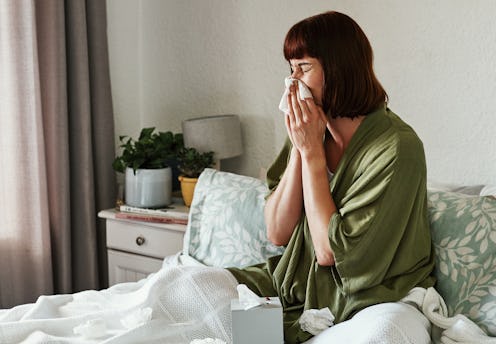Life
House Plants Aren't The Only Culprit Causing Indoor Hay Fever

Streaming eyes and a runny noses are never ideal. But now more than ever, you don’t want to be sneezing while standing in the supermarket queue (just imagine the tutting). So the fact that hay fever season has started early during the COVID-19 lockdown is seriously bad luck for those are us with allergies. You may have thought the fact that you have to stay in this year would mean you’d bypass symptoms but here’s why you’re still suffering from hay fever even while staying inside.
Hay fever is an allergic reaction to pollen, typically occurring when it comes into contact with your mouth, nose, eyes, or throat. Hay fever manifests differently in different people. Symptoms include sneezing, coughing, itchy, red, or watery eyes, itchy throat, mouth, nose, and ears, and headaches. But pollen is something we associate with the outside world, so why are we feeling its effects while cooped up inside?
Indoor triggers
As GP Dr Alka Patel from Babylon Health explains, there are a number of indoor triggers for hay fever, one being dust and dust mites. GP Dr Li Li at Babylon Health agrees, and adds that "spore from fungi and mould" could also be the cause. Both doctors mention "animal danders," which can be anything from tiny flecks of skin or salvia to fur and feathers.
With this in mind, a spring clean has never been more important if you're looking to relieve some of your hay fever symptoms. Dr Patel suggests vacuuming frequently and dusting surfaces down with a damp cloth.
And I'm afraid I have bad news for plant parents: according to Dr Patel, hay fever can also be caused by pollen from indoor plants. She points specifically to weeping figs and bonsai trees as well as flowers like daisies and chamomiles. The moulds in soil can also be a cause of hay fever, so you should watch out for that among your house plants. Even though we all love to add a bit of greenery to our indoor lives, it might be time to reconsider if you're seriously suffering.
High temperatures & pollen count
It’s predicted that the UK is set to experience a mini heatwave in early April, meaning that the pollen count will soar. Met Office forecasters predict pollen levels will peak on April 6 with areas like Kent and London worst hit. With more people taking to their gardens, mowing their lawn, and spring cleaning their houses, you might feel the symptoms of hay fever much more strongly.
During hot weather, we all want to let as much air into the house or flat as possible, but Dr Patel warns that "open windows and doors to the garden can mean that pollen can still drift into the house and stay on soft furnishings and fabrics." If pollen does get inside the house, it's a good idea to try and clean it away.
If you go outside during hay fever season, it's a good idea to shower and change your clothes once to get back to wash all the pollen off.
How to treat hay fever during a lockdown
Taking antihistamines could be your saviour when it comes to hay fever symptoms, and you should be able to pick this up on your next visit to the supermarket. For anything stronger, you'll have to call your GPs office and ask for advice vis-à-vis a prescription. You should not be going into your GP's office unless specifically advised to do so.
You can also combat the triggers inside your house with regular cleaning (a special vacuum cleaner with an HEPA filter is best) and by buying an air purifier that catches pollen and other airborne particles.